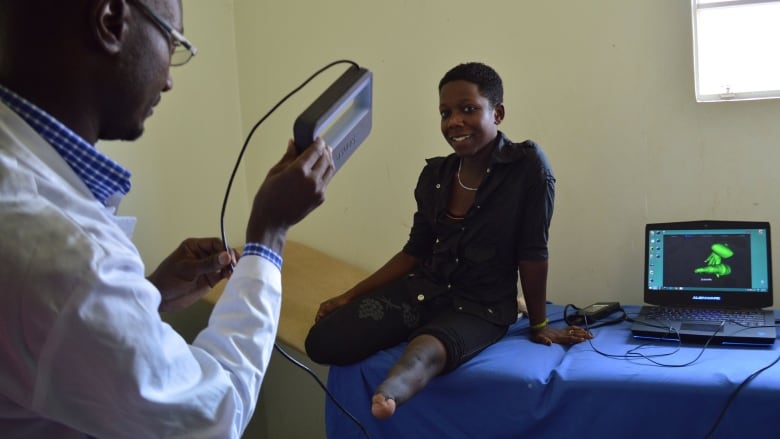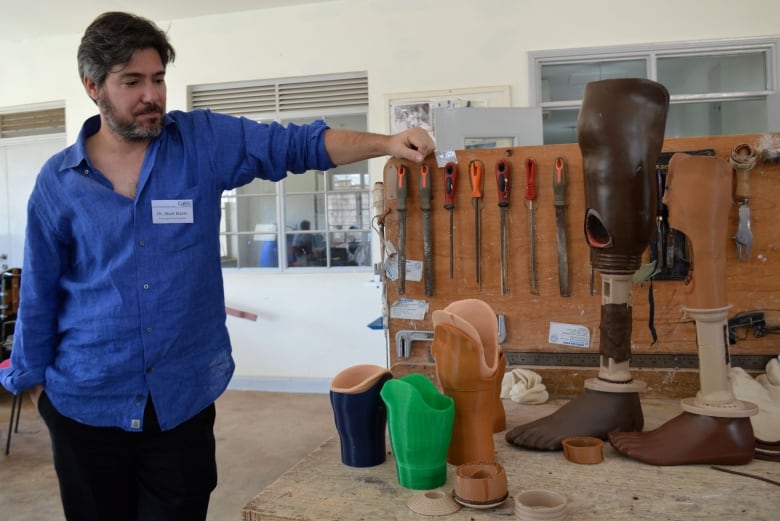Canadian team uses 3D printer to make artificial legs for Ugandans
Researchers provide worlds first functional 3D-printed prosthetic legs to Ugandans

Canadian researchers and a 3D printer are making medical history inUganda.
The Canadian team from the University of Toronto recently helped a young Ugandanwoman walk with the worlds first functional 3D-printed prosthetic leg socket, the critical customized element that is the main component of an artificial limb.
"It makes me feel proud ... its prestigious," says Ruth Nakaye, the 20-year-old fromKampala who received the teams first prosthesis.
During a five-day visit to Kampala in January, the researchers used a 3D printer to make sockets, the customized part of a prosthesis that attaches to an individuals body and forms to the thigh for those with amputations below the knee. They then connected the sockets to the standard pylons and feet that the Red Cross provides for prosthetics in developing countries to complete the replacement limbs.

The Canadian researchers are working with Christian Blind Mission Canada (CBM) andUgandan prosthetists to make limb replacements more affordable and help alleviate theshortage of technicians in developing countries.
3D printing technology has a number of benefits, the team says. It makes the productionof prosthetic limbs more efficient, saving time and money for the patient, which isparticularly important in places like Uganda where many people have very limitedincomes.
It also allows the small number of Ugandan prosthetists to handle more cases than theycould with the time-consuming manual plaster method, says Ratto.
Affordable prostheses
Nakaye, who was born without her full left leg, says she was excited to wear her new3D-printed prosthesis home. Prosthetics have allowed her to play sports and attend school.Nakaye missed two years of primary education because she lacked mobility until acharity paid for her first artificial limb, she says.

The majority of those with physicaldisabilities cant access prosthetics because of the cost, says Dolorence Were,executive director of the Uganda Society for Disabled Children.
Its difficult for many Ugandans 38 per cent of whom live on less than $1.25 US a day to pay at least $300, excluding hospital fees and travel expenses, for a prosthesis,says Mitchell Wilkie, CBMs director of international programs.
Children also grow an average of 2 centimetres a year, and generally need a newprosthesis every six months or so. Patients and their family often need to spend a weekat a hospital and make recurrent visits to get fitted for a new prosthesis. But in Uganda,where 86 per cent of the population survives on subsistence farming, many locals cantafford to pay for prostheses or take time away from their fields, says Wilkie.
Roseline Cheptoo, 4, also received a 3D-printed prosthesis from the Canadianresearchers. It was her third week-long visit for prosthetic fittings, and her family travelledmore than seven hours from Amudat district in northern Uganda to reach the hospital inthe capital city.
"Our parents dont have jobs they grow corn and peanuts and sell any surplus atmarkets," says her brother, Sailas Akodumoi, 19. "Im not sure how my family will affordto pay for future prosthetic legs after the charity ends her sponsorship this year."
Skills shortage
The main issue for Ugandans, however, isnt the cost of prosthetics or hospital services,Ratto says. Its access to skilled people who can fit them.

Studying to become an accredited prosthetist or orthopedic technologist who can makeprosthetics takes at least three years, says Moses Kaweesa, who studied the skill atMakerere University in Kampala.
The World Health Organization (WHO) reports that in the developing world, theres ashortfall of 40,000 prosthetic technicians. It adds that it would take 50 years to train justanother 18,000, according to a 2003 study.
There are approximately 12 prosthetic technicians in Uganda, according to CBM. Andthere are about 10 facilities where prosthetics can be made in the country, adds MalcolmSimpson, chief executive officer of the projects partner hospital.
This is where 3D printers could help.
Currently, it takes three to six days to use plaster to create a negative cast of a residuallimb, fill it and mould a prosthesis, explains Abdullah Issa, a local prosthetist. Adjustmentsare often needed, meaning more manual work.

It takes just a few minutes to do a 3D scan of a residual limb and use software to shapethe prosthesis. Then the printer takes a few hours to produce the customized socketfrom the scan.
The time saved compared to traditional methods of producing a socket will allowprosthetists to see five to six times more patients a week, Ratto says.
It also adds precision, says Issa, who has been working with the technology sinceJanuary. "You can make exact adjustments, rather than guessing like we do with themanual method."
The time-saving technology is also affordable enough that it can be used by facilities indeveloping countries.
"The consumer-grade 3D printers that were using cost $2,000 and $6,000 - and thesoftware, MeshMixer, is free," explains Ratto.
The Ugandan project will continue over the next six months as the Toronto researchersstudy the comfort and durability of the 3D-printed sockets, he says.
And he adds that the project should benefit patients in Canada as well.
"It isnt so much a developed-world technology being redeployed to a developing worldcontext, its exactly the reverse," says Ratto. "Everything were learning through thisproject can be used in developed countries to help produce prosthetics more efficientlyand affordably for Canadians too, and thats whats interesting."












_(720p).jpg)


 OFFICIAL HD MUSIC VIDEO.jpg)
.jpg)



























































































